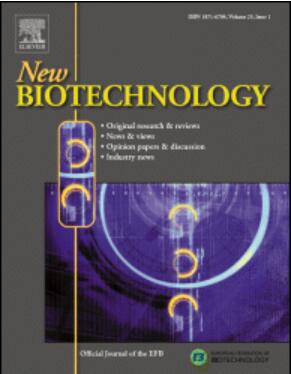Screening assay for polyester hydrolyzing microorganisms using fluorescence-labeled poly(butylene adipate)
IF 4.9
2区 生物学
Q1 BIOCHEMICAL RESEARCH METHODS
引用次数: 0
Abstract
Despite recent advances, there is still a demand for more efficient enzymes hydrolyzing synthetic polymers. Automated high throughput screening strategies of microorganisms from different environments could yield novel enzymes but require specific methods for detection of polymer hydrolysis in complex matrices. Here, 5-carboxy-fluorescein (5-FAM) was covalently coupled to poly(butylene adipate) (PBA) and blended at 1 %, 5 % and 10 % w/w concentrations with non-labeled PBA. Hydrolysis of PBA by the Thc_Cut1 cutinase from Thermobifida cellulosilytica was confirmed via quantification of the released monomers 1,4-butanediol and adipic acid, weight loss and FTIR analysis. Upon incubation with Thc_Cut1, hydrolysis of all three fluorescent labeled PBA blends lead to a clear fluorescence increase of up to 4000 RFU while no signal change was detected for the blank and for heat-inactivated enzyme (signal below 500 RFU). In a next step, as a model organism Pichia pastoris expressing the identical cutinase was cultivated in the presences of labeled PBA. Despite the complex matrix, a fluorescence increase of up to 500 RFU was observed for P. pastoris expressing the enzyme while no significant signal change was seen for the control strain (lacking Thc_Cut1 expression). Likewise, extracellular enzymes from the fungi Fusarium solani and Alternaria alternata hydrolyzed labeled PBA leading to fluorescence increases of 1328 and 1187 RFU. This indicates that 5-FAM covalently coupled to polymers could be used for development of simple and high throughput screening platforms to identify polymer decomposing microorganisms and enzymes.
利用荧光标记聚己二酸丁二醇酯筛选聚酯水解微生物的检测方法。
尽管最近取得了进展,但仍然需要更有效的酶来水解合成聚合物。来自不同环境的微生物的自动化高通量筛选策略可以产生新的酶,但需要特定的方法来检测复杂基质中的聚合物水解。在这里,5-羧基荧光素(5-FAM)与聚己二酸丁烯(PBA)共价偶联,并以1%、5%和10%的w/w浓度与未标记的PBA混合。通过量化释放的单体1,4-丁二醇和己二酸、失重和红外光谱分析,证实了Thermobifida cellulosilytica的Thc_Cut1皮化酶对PBA的水解作用。与Thc_Cut1孵育后,所有三种荧光标记的PBA共混物的水解导致荧光明显增加,最高可达4000 RFU,而空白酶和热失活酶的信号没有变化(信号低于500 RFU)。在下一步中,作为一种模式生物,毕夏巴斯德酵母在标记的PBA存在下表达相同的角质酶。尽管有复杂的基质,但在表达该酶的帕斯德酵母中观察到高达500 RFU的荧光增加,而在对照菌株(缺乏Thc_Cut1表达)中没有观察到明显的信号变化。同样,来自真菌枯萎菌(Fusarium solani)和交替孢霉(Alternaria alternata)的胞外酶水解标记的PBA,导致荧光增加1328和1187 RFU。这表明与聚合物共价偶联的5-FAM可用于开发简单、高通量的筛选平台,以鉴定聚合物分解微生物和酶。
本文章由计算机程序翻译,如有差异,请以英文原文为准。
求助全文
约1分钟内获得全文
求助全文
来源期刊

New biotechnology
生物-生化研究方法
CiteScore
11.40
自引率
1.90%
发文量
77
审稿时长
1 months
期刊介绍:
New Biotechnology is the official journal of the European Federation of Biotechnology (EFB) and is published bimonthly. It covers both the science of biotechnology and its surrounding political, business and financial milieu. The journal publishes peer-reviewed basic research papers, authoritative reviews, feature articles and opinions in all areas of biotechnology. It reflects the full diversity of current biotechnology science, particularly those advances in research and practice that open opportunities for exploitation of knowledge, commercially or otherwise, together with news, discussion and comment on broader issues of general interest and concern. The outlook is fully international.
The scope of the journal includes the research, industrial and commercial aspects of biotechnology, in areas such as: Healthcare and Pharmaceuticals; Food and Agriculture; Biofuels; Genetic Engineering and Molecular Biology; Genomics and Synthetic Biology; Nanotechnology; Environment and Biodiversity; Biocatalysis; Bioremediation; Process engineering.
 求助内容:
求助内容: 应助结果提醒方式:
应助结果提醒方式:


